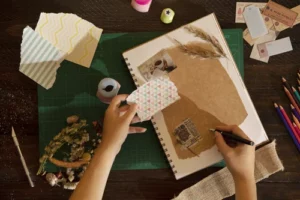In the realm of human creativity, two forms stand out prominently: art and craft. The artistic world is populated by a diverse range of creations, from paintings and sculptures to photography and architecture. On the other hand, the world of crafts encompasses activities like weaving, carving, pottery, embroidery, and macrame. Often, the line between these two creative domains blurs, leading to discussions about their fundamental differences and shared aspects.
Art: The Heartfelt Expression
Art is an expression that emanates from the heart, driven by imagination, feelings, and ideas. It is a visual form of creativity that knows no boundaries, serving as a conduit for emotions, thoughts, and various facets of human ingenuity. Paintings, sculptures, drawings, photographs – all fall under the vast umbrella of art, and they resonate with a sense of aesthetic and emotional value. Take the iconic “Monalisa,” a masterpiece created by Leonardo da Vinci, as an example of how art can encapsulate myriad meanings, each interpretation unique to the observer.
Art is fluid and unstructured, a realm where quantification proves challenging. Unlike crafts, art isn’t meant to be reproducible, for it arises from the individual’s inner self, their innate talents and imaginative prowess. Its impact emerges from the heart and soul of the artist, offering viewers a glimpse into the artist’s world, leaving room for endless interpretations and personal connections. Art transcends tools and materials; it’s an exploration of ideas, feelings, and visual elements that appeal to the mind, forging an emotional link between creator and observer.
Craft: The Mind’s Manifestation
Craft, in stark contrast, springs from the mind, rooted in skill, experience, and technique. It encompasses the creation of tangible objects that serve specific purposes – either decorative or functional, sometimes even both. Crafts are the product of learned abilities, honed through diligent practice and dedication. From birdhouses and woven baskets to embroidery and pottery, crafts reflect the human capacity for turning raw materials into items of practical and aesthetic value.
Craftsmanship revolves around the judicious use of tools and materials, emphasizing the mastery of techniques that can be replicated with precision. Unlike art’s elusive nature, crafts are amenable to reproducibility, enabling artisans to create identical or similar items. The emergence of a craft is a manifestation of acquired skills and experience, a testament to the artist’s dedication to their chosen medium.
Bridging the Gap: Overlapping Realms
While art and craft occupy distinct spaces, their boundaries often blur, resulting in an overlapping spectrum of creativity. For instance, some crafts exude the same expressiveness as art, blurring the line between functional creation and emotional manifestation. This overlap is particularly evident in the evolution of contemporary art, where aesthetics intertwine with emotional resonance, making the distinction between art and craft a matter of interpretation.
Art and Craft Throughout History
Throughout history, the distinction between art and craft has shifted, influenced by cultural, societal, and philosophical factors. The medieval era saw craftsmen and artists sharing similar platforms, with individual recognition reserved for patrons and customers. This communal approach transformed during the Renaissance, ushering in an era where individual creativity and artistic expression gained prominence. Art began to transcend mere utility, fostering deeper connections between creator and audience.
In different parts of the world, the lines between art and craft are more fluid. For instance, intricate Ming Dynasty vases and Peruvian rugs occupy both the craft and art spheres, their value shaped by cultural perspectives. This diversity highlights the evolving nature of artistic categorizations and the intrinsic subjectivity of creative interpretation.
Defining Art: Beyond the Brushstrokes
In the modern context, art encompasses a wide array of forms, from traditional mediums like painting and sculpture to contemporary installations and digital creations. The crux of art lies in its boundless expressive capacity, serving as a platform for conveying emotions, sparking conversations, and challenging societal norms. The traditional forms of art, such as painting, sculpture, and music, continue to evolve alongside emerging mediums like digital art and multimedia installations.
Artists are agents of change, using their creations to influence perceptions, provoke emotions, and address pertinent issues. While aesthetics remain a key element, contemporary art often transcends mere visual appeal, delving into social, political, and philosophical dimensions.
Craftsmanship: Merging Skill and Purpose
Crafts, with their rich heritage of craftsmanship, celebrate the fusion of skill and purpose. From pottery and weaving to woodworking and jewelry making, crafts imbue everyday items with artistry. A well-crafted object serves both functional and aesthetic purposes, enriching daily life with beauty and utility. Unlike the ephemeral nature of some art, crafts endure, contributing to the cultural tapestry of societies across the globe.
Craftspeople, like artists, undergo a journey of mastery, refining their techniques over time. The end products reflect not only the skill of the creator but also a connection to tradition and cultural heritage. Handicrafts, in particular, epitomize the human touch in an era dominated by mass production, embodying the dedication of artisans who bring their creations to life.
Exploring the Spectrum: Shared Traits and Divergent Paths
While art and craft possess distinct characteristics, they share fundamental traits as well. Both require creativity and skill, inviting individuals to explore their imaginative boundaries and refine their techniques. Patience and dedication are essential for mastering either discipline, whether it’s the intricate strokes of a painting or the meticulous weaving of a basket.
Personal satisfaction and appreciation from others form common motivations for engaging in both art and craft. The act of creation itself becomes a source of joy, and the completed works hold the potential to resonate with audiences, evoking emotions and sparking conversations.






